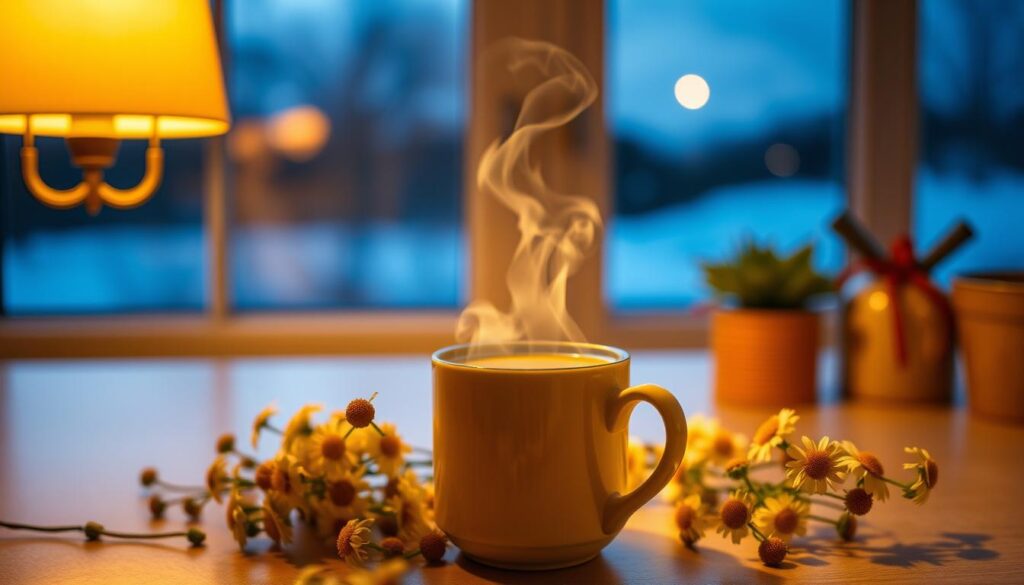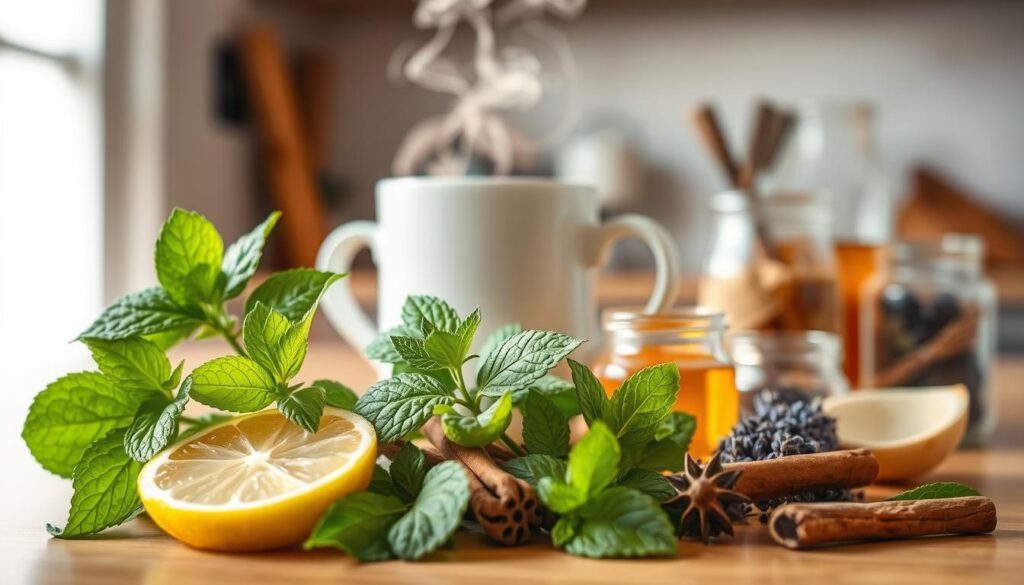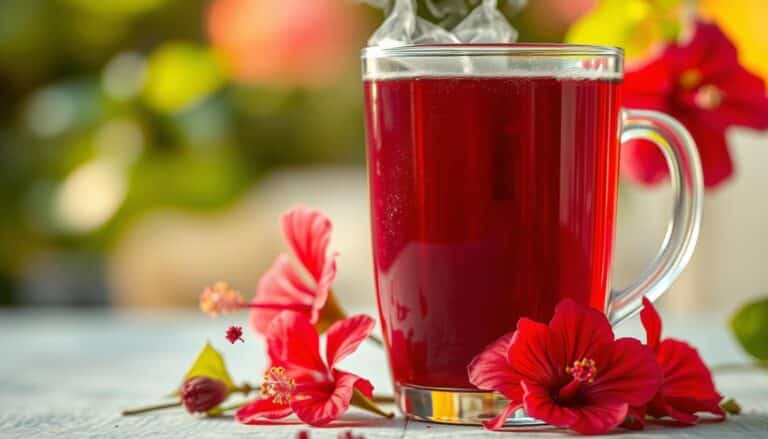Bedtime Herbal Tea: How To Make The Perfect Cup
Making your own herbal tea blends is like an art form. It changes how you relax at night. It’s not just about steeping herbs; it’s about knowing how each one works.
Imagine a tea that tastes great and helps you sleep better. Herbs like chamomile, valerian root, and lavender can make your bedtime routine calming. They help you relax and get ready for sleep.
This guide will teach you about the science and art of herbal tea. You’ll learn how to pick the best herbs and brew them right. Whether you’re tired of store-bought tea or want a special bedtime ritual, you’ll get all the tips you need.
Key Takeaways
- Learn the science behind herbal tea’s sleep-supporting properties
- Discover how to select high-quality herbs for maximum benefits
- Master brewing techniques that enhance flavor and potency
- Create personalized tea blends tailored to your wellness needs
- Transform your nightly routine with natural sleep support
Why Brewing Bedtime Herbal Tea at Home Transforms Your Sleep Routine
Making your own bedtime herbal tea changes your sleep and health. Store-bought tea bags have plastic, lower quality herbs, and waste. Making tea at home lets you choose the best ingredients and control how it’s made.
Here are the great things about brewing herbal tea at home:
- Fresh, high-quality herbs with maximum potency
- Zero artificial preservatives or added sugars
- Customizable flavor profiles
- Cost-effective alternative to commercial teas
Commercial teas often have artificial flavors, preservatives, and sugars that mess with your sleep. Homemade herbal tea lets you pick pure, organic ingredients. These support relaxation and help you sleep better.
Creating your own bedtime tea is a calming ritual. You know what’s in your tea, making it a clean, healthy drink for sleep. The act of making it can also calm you down before bed.
By choosing the quality, flavor, and health benefits, you turn a simple drink into a sleep booster. It’s made just for you.
Understanding the Science Behind Herbal Tea and Better Sleep
Herbal teas are known for helping improve sleep and relaxation. They contain complex chemicals that interact with our body’s systems.
Sleep science shows how plant compounds affect our nervous system. This relationship helps us understand how herbs can support sleep naturally.
How Herbal Compounds Promote Relaxation
Natural herbal compounds have several ways to help us relax:
- Reduce stress hormone production
- Activate neurotransmitter receptors
- Promote muscle relaxation
- Lower overall nervous system activity
The Role of Apigenin in Calming Your Nervous System
Chamomile’s calming effects come from apigenin, a flavonoid. It calms the mind and body. Studies show it can improve sleep and reduce mild depression linked to insomnia.
| Herbal Compound | Primary Sleep Benefit | Mechanism of Action |
|---|---|---|
| Apigenin | Reduced Anxiety | Binds to GABA receptors |
| Flavonoids | Nervous System Relaxation | Neurotransmitter Modulation |
| Herbal Extracts | Stress Reduction | Cortisol Regulation |
Knowing how these compounds work can help you choose the right herbal tea for sleep. Each herb has unique properties that help with relaxation and better sleep.
Choosing the Best Herbs for Your Bedtime Herbal Tea
Choosing the right herbs for your bedtime tea can change how you sleep. Many people struggle with sleep issues like nightmares, sleep apnea, and insomnia. Different herbs can help with these problems. But, some herbs might taste bitter or too strong for you.
When picking herbs for your tea, think about a few things:
- What you want from your tea (relaxation, deep sleep, anxiety relief)
- The unique qualities of each herb
- What you like to taste
Let your taste buds decide. Valerian can be very bitter, and lavender might be too strong. You might prefer a base herb that doesn’t overpower other tastes. Make sure to choose pure, organic whole herbs.
Here are some important things to look for:
- Check the quality of the ingredients
- Smell the herbs to see if they smell good
- Look at how they look
- Choose packaging that’s good for the planet
Good herbal teas smell great and look vibrant. Look for herbs that are fresh, colorful, and have a clear scent. Choosing sustainable packaging helps the environment while you make your sleep tea.
Chamomile: The Classic Sleep-Inducing Powerhouse

Chamomile is known as nature’s top herbal sleep aid. This gentle flower helps those who have trouble sleeping. It has mild sedative properties from apigenin, leading to better rest.
Chamomile’s benefits go beyond its tasty apple-like flavor. Its compounds quickly help you feel sleepy. This makes it a great choice for those who can’t sleep well.
Health Benefits for Sleep Quality
Chamomile offers many sleep and wellness benefits:
- Reduces nighttime awakenings
- Alleviates mild depression symptoms
- Helps calm an overactive nervous system
- Treats menstrual symptoms that disrupt sleep
Growing German Chamomile at Home
Growing chamomile at home is easy. This drought-tolerant annual grows well in the Aster family. It adapts to different gardening setups, needing little care.
Here are some tips for growing German chamomile:
- Plant in areas receiving 6+ hours of sunlight
- Sow seeds directly in cool weather
- Expect flower production within 10 weeks
- Ensure well-draining soil conditions
By growing chamomile, you get a beautiful garden and a fresh supply of sleep tea.
Valerian Root: Nature’s Answer to Falling Asleep Faster
Valerian root has been used for centuries to help people sleep better. It’s a natural way to get a good night’s rest. If you’re having trouble sleeping, valerian root could be the answer you need.
This herb is known for its sleep-enhancing properties. It helps you fall asleep faster by tackling many sleep problems. It also reduces anxiety and promotes deep sleep, making it a top choice for sleep aids.
- Reduces time to fall asleep
- Calms nervous system activity
- Promotes deeper, more sustained sleep
- Natural alternative to synthetic sleep medications
Valerian root tastes quite bitter, which might surprise you. Herbalists suggest mixing it with other herbs to improve taste and effectiveness. Chamomile, lavender, or honey can help balance its strong taste, making your bedtime tea more enjoyable.
Start with a small amount of valerian root tea to see how you react. It’s powerful, and effects can vary. Always talk to a healthcare professional before trying new herbal supplements.
Pro tip: Choose high-quality, organic valerian root for the best sleep benefits. Your path to better sleep might start with just one cup of herbal tea!
Lavender: Aromatic Relief for Restless Minds and Bodies
Lavender is a strong natural remedy for sleep and mental restlessness. Its scent can calm an overactive mind. It’s a top choice for those looking for natural ways to relax.

Lavender is great for sleep challenges. It helps with both mental and physical restlessness. This makes it a complete solution for relaxing at night.
How Lavender Fragrance Soothes Overactive Thoughts
- Reduces anxiety and mental tension
- Helps calm racing thoughts before bedtime
- Promotes a sense of mental tranquility
Lavender is also good for restless leg syndrome or physical nervousness at night. Its natural compounds work with the nervous system. They help quiet both mind and body.
Balancing Lavender’s Distinctive Flavor
Lavender’s strong flavor can be too much on its own. Herbalists suggest mixing it with neutral herbs like chamomile. This creates a balanced and tasty tea blend.
| Lavender Benefit | Impact on Sleep |
|---|---|
| Fragrance Calming | Reduces mental anxiety |
| Physical Relaxation | Eases muscle tension |
| Nervous System Support | Promotes deeper sleep |
When making your bedtime tea, start with a small amount of lavender. Then, adjust it to find your ideal mix. Remember, a little goes a long way with this potent herb.
Essential Tools and Ingredients You Need for Perfect Bedtime Tea
Making the perfect bedtime herbal tea is more than just mixing herbs with hot water. The right tools can make a big difference. They help get the most flavor and health benefits from your herbs.
Essential Brewing Tools
- Kettle with temperature control for precise water heating
- Tea infuser or teapot with built-in filter
- Measuring spoon or kitchen scale
- Ceramic or glass mug
A good kettle with temperature control is key. It lets you heat water just right for your herbs. A tea infuser or teapot with a strainer is great for loose leaf teas. And, using a kitchen scale or measuring spoon ensures you get the right amount of herbs.
Key Ingredients for Your Bedtime Brew
| Ingredient Category | Recommended Options |
|---|---|
| Water Base | Filtered water (removes chlorine and mineral impurities) |
| Tea Base | Loose leaf herbal tea or plastic-free tea bags |
| Optional Enhancers | Raw honey, fresh lemon, cinnamon, plant-based milk |
The water you use can change the taste a lot. Filtered water gives a clean, pure flavor. Loose leaf herbs often taste richer than tea bags. Adding honey or plant-based milk can make your tea even more comforting.
Step-by-Step Guide to Brewing the Perfect Cup of Bedtime Herbal Tea
Making the perfect bedtime herbal tea is an art. It turns your evening into a relaxing ritual. With the right steps, you can enjoy your favorite sleep herbs fully. This creates a calming routine that gets your body and mind ready for sleep.
Precision in Herb Measurement
Getting the brew just right starts with measuring your herbs correctly. Here are some key tips for your bedtime tea:
- Use 1 tablespoon of dried chamomile blooms per 8-ounce cup
- For fresh flowers, increase to 2 tablespoons
- Employ a tea infuser for loose herbs
- Measure 1 teaspoon of loose leaf tea per 8-oz cup
Water Temperature and Steeping Secrets
The water temperature is key for getting the best flavor and health benefits from your herbs. Here’s a detailed guide to brewing like a pro:
| Herb Type | Water Temperature | Steeping Time |
|---|---|---|
| Chamomile | 200-212°F (93-100°C) | 5-10 minutes |
| Herbal Blends | Boiling water | 5-10 minutes |
Pro tip: Always use fresh filtered water and avoid reboiling to retain oxygen and preserve the tea’s delicate flavors.

Remember to cover your mug while steeping to trap those aromatic essential oils. Once steeped, remove the herbs and pour your perfectly crafted bedtime tea into your favorite mug. Your path to a peaceful night’s sleep is just moments away.
Creating Your Own Custom Sleepy Time Tea Blend
Making the perfect bedtime tea is an art that mixes science and taste. Your own sleepy time blend can change your bedtime routine. It helps you sleep better and feel more relaxed.
The basic recipe for a sleepy time blend is simple: 3 parts chamomile, 1 part dried valerian root, and 1 part lavender. This mix helps you sleep well by calming your mind and body.
- Chamomile provides a gentle, apple-like base
- Valerian root acts as a quick sleep inducer
- Lavender offers aromatic anxiety reduction
When you measure your herbs, “parts” can mean different amounts. It could be a teaspoon, tablespoon, or scoop, depending on how much tea you want. You can make just one mug or a big batch to store in a jar.
| Herb | Quantity | Sleep Benefits |
|---|---|---|
| Chamomile | 3 parts | Gentle relaxation, mild sedative |
| Valerian Root | 1 part | Faster sleep onset |
| Lavender | 1 part | Reduces anxiety, calms thoughts |
Pro tip: Chamomile and lavender balance out valerian’s bitter taste. This way, you get great sleep benefits without a bad taste. Try different ratios to find your ideal blend for a good night’s sleep.
Enhancing Your Bedtime Tea with Natural Add-Ins
Making the perfect bedtime herbal tea is more than picking herbs. Adding natural ingredients can make your tea better in taste and help you sleep. You can turn your tea into a special drink for relaxation with the right mix.

Sweetening Options That Support Sleep
Choosing the right sweetener can make your bedtime tea better without affecting your sleep. Natural sweeteners have special benefits:
- Raw honey supports melatonin production
- Maple syrup provides mineral-rich sweetness
- Stevia offers zero-calorie sweetening
Complementary Herbs for Enhanced Relaxation
Lemon balm and rose petals are great for sleep. They can make your tea a strong tool for relaxation.
| Herb | Sleep Benefits | Flavor Profile |
|---|---|---|
| Lemon Balm | Reduces anxiety | Mild citrusy |
| Rose Petals | Calms nervous system | Delicate floral |
| Spearmint | Promotes relaxation | Cool and refreshing |
Many of these herbs can grow in your garden. This lets you make tea that’s just for you. You can also add things like lemon, honey, cinnamon, or plant-based milk to make it even more special.
Common Mistakes to Avoid When Making Bedtime Herbal Tea
Making the perfect bedtime herbal tea is more than just a simple task. Many people unknowingly ruin their relaxing drink by making big mistakes. These errors can mess up the flavor and strength of the tea.
Water quality is key when brewing tea. Tap water can add unwanted stuff and change the taste of your herbal mix. Filtered or spring water is best to keep the true taste of your herbs.
- Avoid oversteeping your tea, which makes it bitter and unpleasant
- Use precise water temperatures for different herb types
- Store herbs in proper containers to maintain quality
Temperature is also very important in making herbal tea. Water that’s too hot or too cold won’t get all the good stuff from your herbs. For example, teas made from roots like valerian need warmer water than teas from flowers.
| Herb Type | Ideal Water Temperature | Steeping Time |
|---|---|---|
| Chamomile | 200°F | 3-5 minutes |
| Lavender | 190°F | 2-4 minutes |
| Valerian Root | 210°F | 5-7 minutes |
Storing tea the wrong way can quickly ruin your herbs. Air, light, heat, and moisture can all hurt the taste and health benefits. Use airtight, dark containers and keep them in a cool, dark place away from sunlight and heat.
By avoiding these common mistakes, you’ll make a perfect, healing bedtime herbal tea. It will help you relax and sleep better.
Storing Your Herbal Tea Blend for Maximum Freshness and Potency
Keeping your homemade herbal tea blend fresh is key. It can lose its strength if stored wrong.
To keep your tea’s taste and health benefits, you need the right storage. Protect your herbal blend from four major enemies of freshness:
- Air (causes oxidation)
- Light (breaks down delicate plant chemicals)
- Heat (accelerates deterioration)
- Moisture (can cause mold growth)
Use dark glass or ceramic containers to keep air, light, and moisture out. Place them in a cool, dark spot, away from heat. Glass is best because it doesn’t hold smells or chemicals like plastic can.
Herbs last different lengths of time. Flowers like chamomile and lavender stay fresh for 6 months. Roots like valerian can last up to 12 months if stored right.
Remember to label your containers with the herb name, where it came from, and when you got it. This way, you know when to use your tea for the best taste. For brewed tea, keep leftovers in the fridge in an airtight container for up to two days.
By storing your herbal tea the right way, it will stay strong and tasty for your evening calm.
How to Harvest and Dry Chamomile Flowers for Tea
Growing your own chamomile for homemade tea is rewarding. It connects you with nature’s healing power. Chamomile flowers are delicate treasures that need careful attention during harvesting and drying.
Your chamomile plants will bloom about 10 weeks after sowing seeds. The best time to harvest is when the white petals are fully open and the yellow center is plump and vibrant.
Perfect Timing for Chamomile Harvest
To get the most from your chamomile, follow these harvesting tips:
- Pick flowers in the morning after dew has dried
- Harvest before the day’s intense heat sets in
- Select flowers with fully opened petals
- Cut flowers carefully to avoid damaging the plant
Effective Drying Techniques
Proper drying is key to keeping your chamomile flavorful and medicinal. Bring your freshly harvested flowers inside to dry using these methods:
- Spread flowers in a single layer on parchment paper
- Choose a warm, dry location with good air circulation
- Keep flowers away from direct sunlight
- Allow two weeks for complete drying
Your chamomile is ready when petals crumble easily between your fingers. Store in an airtight container to keep it fresh. Enjoy your homegrown tea all year round.
Conclusion
Brewing your own bedtime herbal tea is more than just a drink. It’s a wellness practice that lets you control what goes into it. Learning about herbs like chamomile, valerian, and lavender helps you make blends that help you sleep better.
Making the perfect herbal tea takes time and patience. Begin with a mix of chamomile, valerian, and lavender. Then, adjust it based on what works for you. Paying attention to how you measure, the water temperature, and steeping time makes a big difference.
This bedtime ritual is a gentle way to improve your sleep. It’s a natural choice that works with your body, not against it. Enjoying a warm herbal tea can be calming and helps the herbs work better. It’s a way to care for yourself and support your health for years to come.
Creating the perfect bedtime herbal tea is a personal journey. Each cup is a chance to learn about natural healing and what your body needs. It helps you develop a calming routine that supports your health and well-being.







